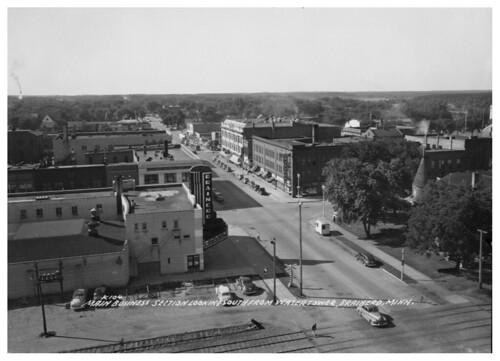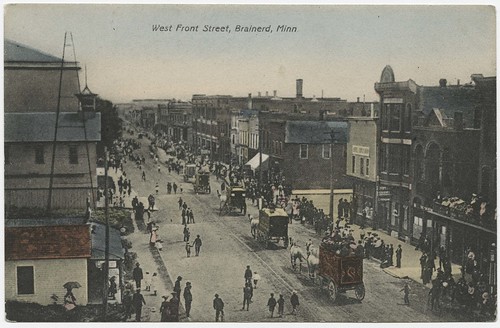The good old days
Our Curbside Chat program, where we go out and speak with communities about the current economic crisis and how it is impacting cities, is often as enlightening for us as it is for the public officials and others that participate.
For example, last week in the City of Emily, one Chat participant made the observation that, if the city were to revert to the development pattern of 1950, they would need "40 or 50 new businesses". We all kind of gave him with a "what are you talking about" look. So he explained.
Sixty years ago, when the population of Emily was less than a third of what it is today (2009 est. of 1000), there were all kinds of businesses in town. There was a bakery, three additional restaurants, clothing stores, hotels, a hardware store and all of the things that Emily residents today are dieing to have. In the intervening years, those businesses have all closed. If we were going to start rebuilding the city using a traditional pattern of development, we would need to bring these places back.
Bingo.
Back before we invested our fortunes in creating growth and economic development, back before federal subsidies for infrastructure, before the mortgage interest deduction, before Tax Increment Financing and economic development agencies, before Euclidean zoning, before comprehensive planning and even before the DOT, before all of these tools we use to "grow", what did we have?
We had something that, by today's standards, looks a little like prosperity.
While we were investing in the future, the businesses in Emily -- and many other parts of the country -- were being systematically put out of business. The local economies turned into regional economies, forcing many of the small players out. As towns were devolved to an auto-orientation, the competitive advantage of local businesses (proximity) was overwhelmed by the competitive advantages of modern globalism (quantities of scale). Our local economies collapsed.
Consider these historic photos from my hometown of Brainerd, MN. I've been saving these for a series I plan to run when the weather is nicer and I can take some before/after photos, but this will give you a little flavor of the town prior to the interstate era.
These photos look nothing like Brainerd does today. For starters, look at all of the people out and about. We only have this level of activity today on the Fourth of July or during police raids on meth factories.

The remarkable thing about this photo is that the two major buildings in the center of the photo as well as the theatre in the foreground are gone, the land turned into parking lots. Parking lots that provide no jobs and no tax base. We'd give every subsidy we could imagine to bring these buildings back.

Here's another photo that is mind-boggling. This seems to be a parade of some sort, so the amount of people gathered may be atypical, but look at the stuff we built way back when we were a truly poor country. Not only was this beautiful streetscape done without the benefit of zoning, building codes or likely even architects, but imagine the number of people employed, the tax base it provided and the number of transactions taking place daily. Today, every structure here is gone with the land turned almost exclusively into parking.

Now, we're not going to pretend here at Strong Towns that this pictures represent utopia while the modern Brainerd is a version of post WW II Dresden. There was nobody manufacturing computers here in 1950 and high-paying, professional jobs were not to be found in abundance. There is no arguing with the notion that we are better off in many, many ways today.
But our passion here at Strong Towns is with the productivity (or lack thereof) of our land use pattern. There is no question that the pattern shown in these photos, the one described by our Emily resident for his town two generations ago, was far more productive than the one we have evolved into today. These places were economically viable and resilient by definition. If they were not, they became ghost towns. That fact in and of itself tends to make people more thoughtful about where they place their priorities and how they spend their resources.
We don't advocate a return to the economics of 1950, but there is a lot to learn, and a lot of lessons we can take, from the model they used before America had all of the "wealth" and "prosperity" we have today. Our towns and neighborhoods may not be able to manufacture computers to meet the local demand, but there is no good reason why our daily bread has to be trucked in from sixty miles away, preservatives and all.
We can solve our unemployment problem and our municipal finance crisis with a different pattern of development. We can solve these problems by building Strong Towns.
Want to support this blog? Now you can. We've finally received our 501(c)3 letter from the IRS and are now able to accept tax deductible donations. If you value what you read here, consider a donation to help spread the Strong Towns movement. We would be very grateful for your support.
